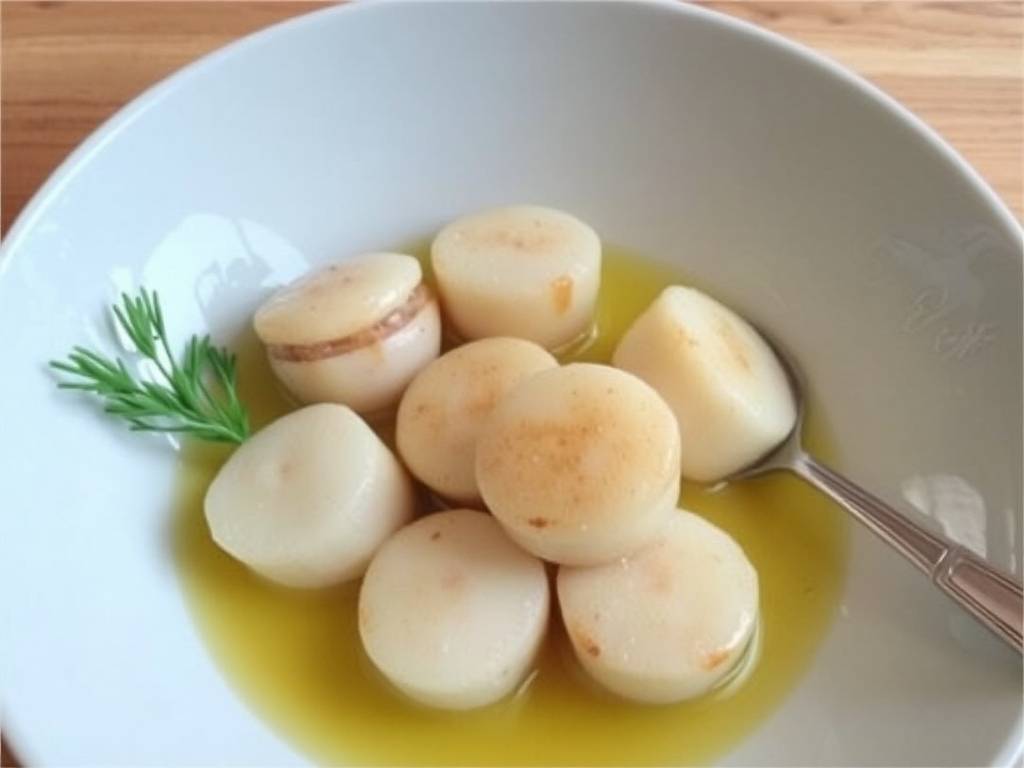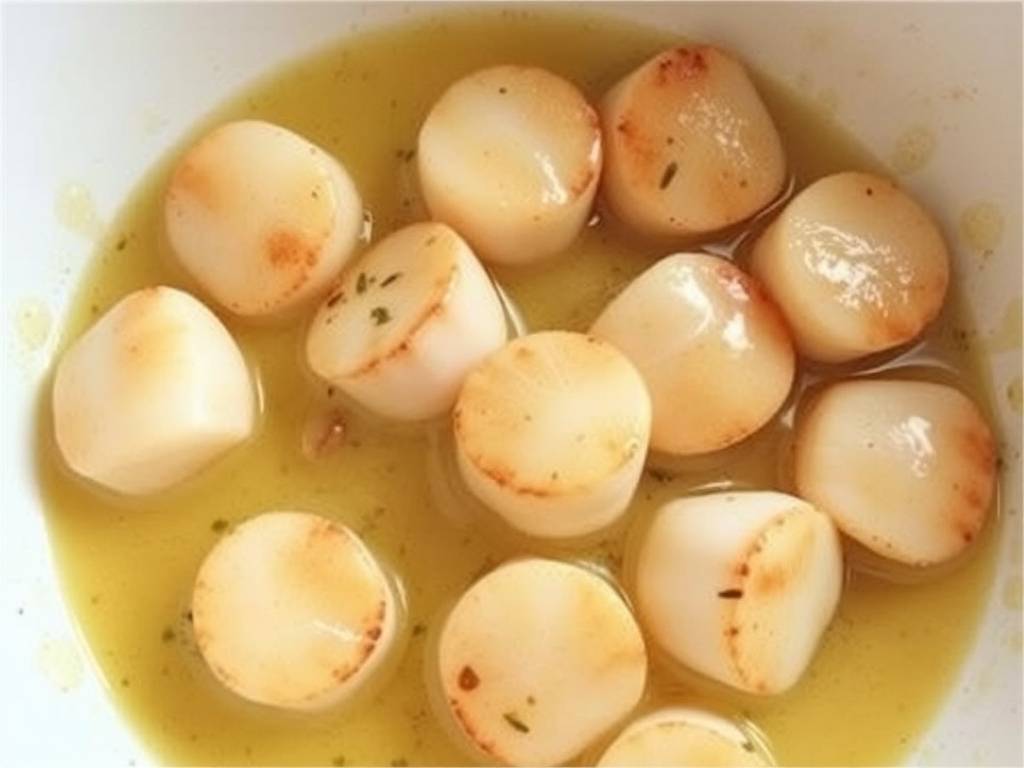The Art of Perfect Pan-Seared Scallops with White Wine Garlic Sauce
There's something truly magical about the moment plump, sweet scallops meet a hot pan. That satisfying sizzle signals the start of something extraordinary, especially when you're creating a classic dish that never fails to impress. Today, we're diving deep into the world of cooking scallops with white wine and garlic - a combination that transforms simple ingredients into an elegant culinary experience.
Many home cooks feel intimidated by seafood, particularly when it comes to achieving that perfect golden-brown crust while maintaining a tender, almost creamy interior. But fear not - with the right techniques and understanding, you'll be serving restaurant-quality scallops that will make your dinner guests think you've been training with professional chefs.

Let's start with the star ingredient: the scallops themselves. When selecting scallops for this white wine garlic scallops recipe, you'll want to look for "dry-packed" scallops rather than "wet-packed." This distinction is crucial for achieving that beautiful sear we're after. Wet-packed scallops have been treated with phosphates that make them absorb water, which means they'll steam rather than sear when they hit the pan. Dry-packed scallops haven't undergone this treatment, allowing for proper browning and more concentrated flavor.
If you're wondering how to tell the difference, just ask your fishmonger - they'll know exactly what you're looking for. Another visual clue is the color; truly fresh, dry-packed scallops should appear creamy white or pale beige with a firm texture. Avoid any that look stark white or are sitting in milky liquid.
Now, let's talk about the essential preparation steps that many recipes gloss over but make all the difference in your final dish. About 15 minutes before cooking, remove your scallops from the refrigerator and place them on a plate lined with paper towels. Pat them thoroughly dry on all surfaces - this is non-negotiable for achieving that perfect sear. Moisture is the enemy of browning, so take your time with this step. While they're coming to room temperature, you can season both sides generously with salt and pepper.
The pan you choose matters more than you might think. A heavy-bottomed stainless steel or cast iron skillet works beautifully for searing scallops because they distribute heat evenly and can maintain high temperatures when the scallops are added. Non-stick pans simply won't give you the same level of browning, though they can work in a pinch if that's what you have available.
Heat your pan over medium-high heat until it's properly hot - this typically takes 2-3 minutes. Add a high-smoke-point oil like avocado oil or grapeseed oil, though clarified butter also works wonderfully. Wait until the oil shimmers but doesn't smoke, then carefully add your scallops one by one, making sure not to overcrowd the pan. If you crowd them, they'll steam rather than sear, so work in batches if necessary.
Here's a pro tip: use tongs to place each scallop in the pan, starting from the outside edge and working your way inward in a clockwise pattern. This ensures they cook evenly since the ones placed first will have a head start. Resist the temptation to move them around! Let them develop that beautiful crust for 1.5-2 minutes before flipping. You'll know they're ready to turn when they release easily from the pan.
While your scallops are developing that gorgeous color on the second side, it's time to think about our flavorful companions: garlic and white wine. The type of white wine you choose for cooking scallops matters more than the price tag. You'll want a dry white wine with good acidity - Sauvignon Blanc, Pinot Grigio, or an unoaked Chardonnay all work beautifully. The rule of thumb is to cook with wine you'd enjoy drinking, but there's no need to break the bank. Just avoid "cooking wines" from the grocery store, as they often contain added salt and preservatives that can throw off your dish's balance.

Once your scallops have developed color on both sides (they should feel firm but still slightly yielding to the touch), remove them from the pan and set them aside on a clean plate. Now, reduce the heat to medium and add your minced garlic to the same pan. The residual fats and those delicious browned bits left from the scallops will form the foundation of our sauce. Cook the garlic for just 30-60 seconds until fragrant - be careful not to burn it, as burnt garlic becomes bitter.
Now comes the dramatic part: deglazing the pan with white wine. Pour in about half a cup of your chosen wine - it will sizzle and steam impressively. Use a wooden spoon or spatula to scrape up all those flavorful browned bits from the bottom of the pan. This process, known as "deglazing," is where much of the sauce's complexity comes from. Let the wine reduce by about half, which will take 2-3 minutes of simmering.
At this point, many recipes would have you finish the sauce with cold butter, and while that's a classic technique, I want to share a variation that adds incredible depth: incorporate a tablespoon of tomato paste along with the garlic and let it cook for a minute before adding the wine. This creates a richer, more complex base for your sauce. After the wine has reduced, swirl in 2-3 tablespoons of cold butter to create a luscious, emulsified sauce. If you're feeling adventurous, a teaspoon of fresh lemon juice or chopped herbs like parsley or chives brightens everything up beautifully.
Now for the grand finale: return your seared scallops to the pan along with any accumulated juices, spoon the sauce over them, and let everything heat through for just about 30 seconds. This allows the flavors to marry while ensuring your scallops don't overcook.
When it comes to serving your garlic white wine scallops, timing is everything. Have your plates warmed and your side dishes ready before you even start cooking the scallops, as they come together quickly and are best served immediately. These scallops pair beautifully with simple accompaniments that don't compete for attention - creamy polenta, risotto, angel hair pasta, or even just crusty bread to soak up that incredible sauce. For vegetables, roasted asparagus, sautéed spinach, or green beans almondine all make excellent choices.
If you find yourself with leftovers (though I doubt you will!), store them in an airtight container in the refrigerator for up to two days. To reheat, place them in a skillet over low heat with a tablespoon of water or wine to help recreate the sauce's consistency. Avoid microwaving, as this will make the scallops rubbery.
For those looking to master different cooking methods, you might wonder about alternative approaches like baking or broiling scallops. While pan-searing delivers the best texture contrast, you can certainly adapt this recipe by placing seasoned scallops in a baking dish, pouring the white wine garlic sauce over them, and baking at 400°F for 12-15 minutes. The results will be different - less crispy but still delicious - and particularly helpful when cooking for a crowd.
The beauty of this white wine garlic scallops recipe lies in its versatility. Once you've mastered the basic technique, feel free to experiment with additions like chopped shallots along with the garlic, a splash of cream for a richer sauce, or different herb combinations. The fundamental principles remain the same: dry scallops, hot pan, don't overcrowd, and build your sauce from the flavorful foundation left behind.
Cooking perfect scallops might seem daunting at first, but with these detailed steps and explanations, you're equipped with everything needed to create a spectacular dish. The combination of sweet, tender scallops with the bright acidity of white wine and the aromatic punch of garlic is truly timeless. So next time you're looking to create a special meal that feels luxurious but comes together in minutes, remember that these restaurant-quality pan-seared scallops with white wine garlic sauce are well within your reach.






发表评论